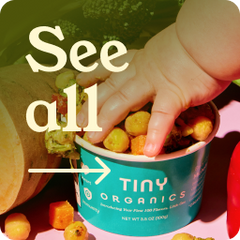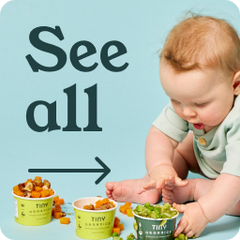Why Your Child’s First 100 Flavors Matter

There is evidence that early exposure to flavors and textures will make your child a less picky eater (10). So, why do flavors and textures matter? Children have a natural preference for sweet and smooth foods that are easy to eat (22). However, most foods - and most foods that are good for us - don’t fall into this simple, “sweet and smooth” category. Most children have an aversion to bitter tastes (more commonly found in the ultra-healthy stuff, ie. green vegetables). The good news is that by familiarizing little ones to more complex foods, flavors and textures early on, they are more likely to eat a wider variety of foods later.
At Tiny Organics, our goal is to introduce your child to their first 100 flavors to build lifelong adventurous eaters and to reduce picky eating. We have developed meals that will introduce your little one to a variety of diverse flavors and textures from around the world and make mealtime fun and successful in both the short and long-term.
There are studies that indicate the more vegetable variety a child is exposed to, the more willing they are to try and accept a new vegetable. A recent study (44) found that children who were exposed to vegetables and fruits at 4.8 months had a higher intake of them later in childhood compared to children who were exposed to fruits and vegetables at 6.2 months. Takeaway: The earlier you can expose your child to new flavors and different fruits and vegetables, the more likely they are to eat those vegetables later in life.
Now onto textures!!
Children inherently prefer smooth foods, but vegetables and fruits often have inconsistent textures. Between the ages of 6-12 months a child is developing their oral-motor skills. Even without teeth, children are able to use their tongue to move solid foods around their mouths (55). In a 2001 longitudinal study, children who were exposed to lumpy textures before 10 months compared to children that were exposed at 10 months were less fussy towards textured foods at 15 months and had fewer feeding problems at 7 years (60). Whether a child is breastfed or formula-fed, exposing them to new foods during sensitive periods (flavors = from 4-6 months, texture = 6-10 months) is the most impactful way to expand a child’s taste palate (42). Takeaway: The earlier you can expose your child to different textures, the more likely they are to accept textured foods later in childhood. We make meals that will introduce your child to new textures and help them develop their oral-motor skills!
Bottom Line: The earlier and the more textures and flavors you can expose your child to in their first year, the less likely they are to develop a fear or aversion to new flavors and textures later in childhood.
References:
Harris, G., & Coulthard, H. (2016, March). Early Eating Behaviours and Food Acceptance Revisited: Breastfeeding and Introduction of Complementary Foods as Predictive of Food Acceptance. Retrieved from https://www.ncbi.nlm.nih.gov/pmc/articles/PMC4796330/
(10) Maier, A. S., Chabanet, C., Schaal, B., Leathwood, P. D., & Issanchou, S. N. (2008, December). Breastfeeding and experience with variety early in weaning increase infants' acceptance of new foods for up to two months. Retrieved from https://www.ncbi.nlm.nih.gov/pubmed/18838198
(22) Desor, J. A., & Beauchamp, G. K. (1987). Longitudinal changes in sweet preferences in humans. Retrieved from https://www.ncbi.nlm.nih.gov/pubmed/3588712
(35) Hausner, H., Bredie, W. L., Mølgaard, C., Petersen, M. A., & Møller, P. (2008, September 03). Differential transfer of dietary flavour compounds into human breast milk. Retrieved from https://www.ncbi.nlm.nih.gov/pubmed/18571209
(42) Hausner, H., Nicklaus, S., Issanchou, S., Mølgaard, C., & Møller, P. (2010, February). Breastfeeding facilitates acceptance of a novel dietary flavour compound. Retrieved from https://www.ncbi.nlm.nih.gov/pubmed/19962799
(44) Cooke, L., Carnell, S., & Wardle, J. (2006, July 06). Food neophobia and mealtime food consumption in 4-5 year old children. Retrieved from https://www.ncbi.nlm.nih.gov/pmc/articles/PMC1557859/
(55) Gisel, E. G. (1991, January). Effect of food texture on the development of chewing of children between six months and two years of age. Retrieved from https://www.ncbi.nlm.nih.gov/pubmed/1995410
(60) Northstone, K., Emmett, P., Nethersole, F., & ALSPAC Study Team. Avon Longitudinal Study of Pregnancy and Childhood. (2001, February). The effect of age of introduction to lumpy solids on foods eaten and reported feeding difficulties at 6 and 15 months. Retrieved from https://www.ncbi.nlm.nih.gov/pubmed/11301932



















